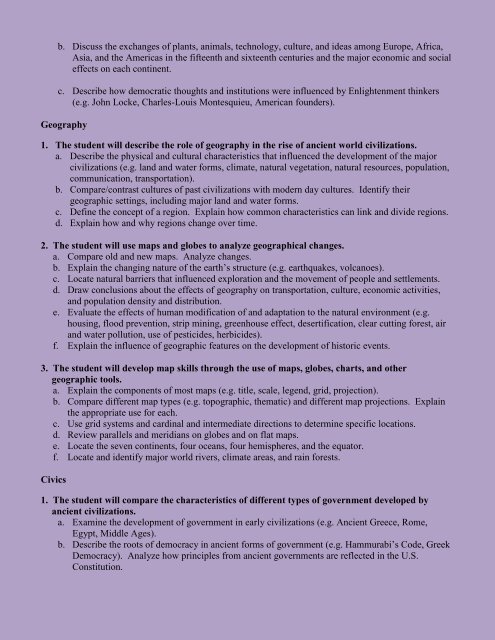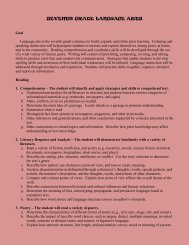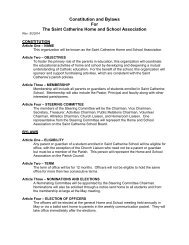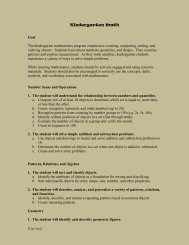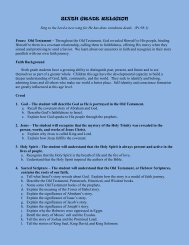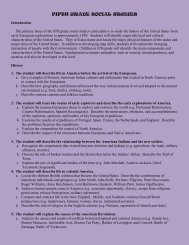SIXTH GRADE SOCIAL STUDIES - Saint Catherine School
SIXTH GRADE SOCIAL STUDIES - Saint Catherine School
SIXTH GRADE SOCIAL STUDIES - Saint Catherine School
You also want an ePaper? Increase the reach of your titles
YUMPU automatically turns print PDFs into web optimized ePapers that Google loves.
. Discuss the exchanges of plants, animals, technology, culture, and ideas among Europe, Africa,<br />
Asia, and the Americas in the fifteenth and sixteenth centuries and the major economic and social<br />
effects on each continent.<br />
c. Describe how democratic thoughts and institutions were influenced by Enlightenment thinkers<br />
(e.g. John Locke, Charles-Louis Montesquieu, American founders).<br />
Geography<br />
1. The student will describe the role of geography in the rise of ancient world civilizations.<br />
a. Describe the physical and cultural characteristics that influenced the development of the major<br />
civilizations (e.g. land and water forms, climate, natural vegetation, natural resources, population,<br />
communication, transportation).<br />
b. Compare/contrast cultures of past civilizations with modern day cultures. Identify their<br />
geographic settings, including major land and water forms.<br />
c. Define the concept of a region. Explain how common characteristics can link and divide regions.<br />
d. Explain how and why regions change over time.<br />
2. The student will use maps and globes to analyze geographical changes.<br />
a. Compare old and new maps. Analyze changes.<br />
b. Explain the changing nature of the earth’s structure (e.g. earthquakes, volcanoes).<br />
c. Locate natural barriers that influenced exploration and the movement of people and settlements.<br />
d. Draw conclusions about the effects of geography on transportation, culture, economic activities,<br />
and population density and distribution.<br />
e. Evaluate the effects of human modification of and adaptation to the natural environment (e.g.<br />
housing, flood prevention, strip mining, greenhouse effect, desertification, clear cutting forest, air<br />
and water pollution, use of pesticides, herbicides).<br />
f. Explain the influence of geographic features on the development of historic events.<br />
3. The student will develop map skills through the use of maps, globes, charts, and other<br />
geographic tools.<br />
a. Explain the components of most maps (e.g. title, scale, legend, grid, projection).<br />
b. Compare different map types (e.g. topographic, thematic) and different map projections. Explain<br />
the appropriate use for each.<br />
c. Use grid systems and cardinal and intermediate directions to determine specific locations.<br />
d. Review parallels and meridians on globes and on flat maps.<br />
e. Locate the seven continents, four oceans, four hemispheres, and the equator.<br />
f. Locate and identify major world rivers, climate areas, and rain forests.<br />
Civics<br />
1. The student will compare the characteristics of different types of government developed by<br />
ancient civilizations.<br />
a. Examine the development of government in early civilizations (e.g. Ancient Greece, Rome,<br />
Egypt, Middle Ages).<br />
b. Describe the roots of democracy in ancient forms of government (e.g. Hammurabi’s Code, Greek<br />
Democracy). Analyze how principles from ancient governments are reflected in the U.S.<br />
Constitution.


